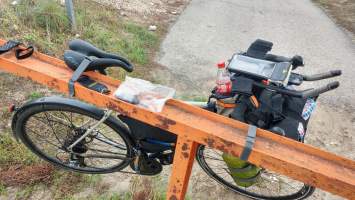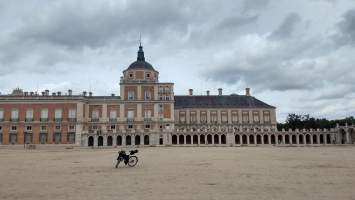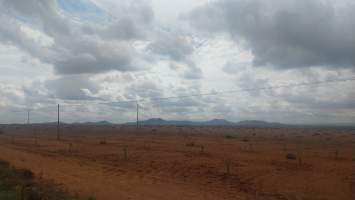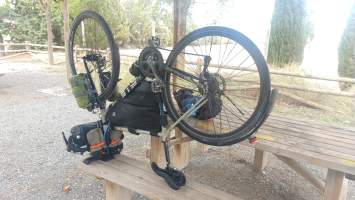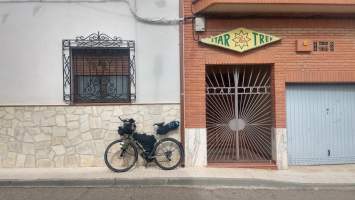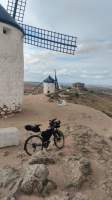Aranjuez
Leaving Madrid turned out to be rather simple: I took the same road to the center as yesterday and then just followed the bike path along the río Manzanares south. There I met many more road cyclists today than yesterday, I guess the Aranjuez loop is among the go-to rides for the locals.
As already mentioned yesterday’s inner tube replacement left my rear wheel with a misaligned tire which I intended to fix on the road today. Outside Madrid I found a decent spot for repairs with an iron barrier that I repurposed as a bike stand using two velcro straps. There I massaged the tire over and over again, pushing it into the rim to reposition the parts where it had popped out too much when inflating. Quite the frustrating work that shouldn’t even be necessary but for some reason that Marathon tire refuses to wrap itself correctly around the Andra 35 rim. The result was a noticable improvement, I had evened out the dent somewhat so on a bumpy road surface I wouldn’t feel the warped tire. Still not satisfactory as on better roads I would still feel the wheel rocking underneath me. But I had enough of repairs for now so I accepted that less than ideal situation.
Aranjuez was smaller than I thought, both the town and the palace. Reportedly the gardens are quite extensive but I skipped those, having been turned away by the security lackey at the entrance. After a lunch break at the main fountain opposite the castle I went on my way again.
Lost in La Mancha
Heading south I had to climb out of the río Tajo valley which I did on one of the larger roads I’ve been using. It was in a state of disrepair with bushes growing onto the lanes from the sides and crumbling tarmac but in its day it might have been an aspiring autovia with the two lanes each way and a sizeable grass strip in the middle.
At the top of that climb I was once again greeted by headwind which was haunting me consistently during the day, however today it wasn’t blowing nearly as strong as two days ago on the Navacerrada. Then the terrain got flat, eerily flat for an altitude of 900 meters. I had reached the famous La Mancha region.
Anyways, I was only fighting the wind, not the windmills. Of which there weren’t that many to begin with; considering the region’s fame for strong winds I’d have assumed it was riddled with power plants. Instead, it wouldn’t be much of an exaggeration to say that La Mancha is a single contiguous olive plantation; Spain’s richest oil fields if you will.
On the Ruta de Don Quijote I finally had enough of the wobbling rear wheel and stopped for another repair attempt at a rest area that worked quite well as an impromptu bike shop. This time I had more luck pushing the tire into position and ended up aligning it almost perfectly. In any case I did a much better job than last time I had to replace the inner tube on the slopes of the Stelvio.
As curious as I was about the result of that second repair break, I didn’t get the opportunity to evaluate it for a while because a few meters after that rest stop the road turned into a gravel track. And once more this wasn’t just some smooth, compacted sterrato but a rough surface intended to be used by heavy agricultural implements, certainly not by touring bikes with aging 37 mm tires. About two kilometers in while fighting with a steep incline a car was going in the opposite direction and the driver – I’m assuming the owner of the olive groves checking in on his trees – gave me an enthusiastic thumbs up.
When I was back on asphalt I was relieved to finally get the confirmation that the dent in the rear tire was in fact gone. Plus it just survived that off-road stretch without losing air which is a strong sign the tire might not be EOL yet after all.
I had to climb one more hill and there it was: behold the windmills of Consuegra. The mills are in remarkably good state, Don Quijote’s attacks didn’t even leave a scratch on those brick walls. Dodging the tourists – a busload of them had just arrived – I made my way up to the top of that rock and enjoyed the panorama of the amazing countryside.
150 km despite two longer repair delays, not bad. But with just 1100 m of climbing on mostly easy gradients this wasn’t an overly taxing ride.
